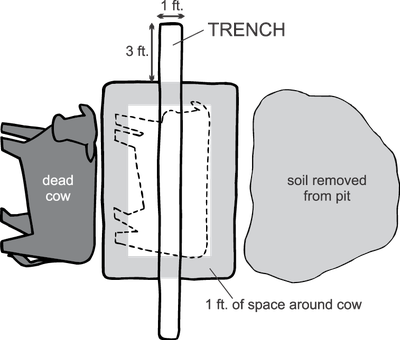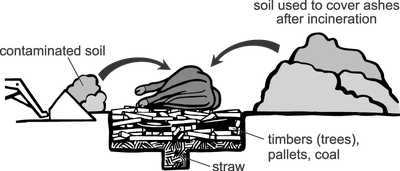Anthrax (V561, Revised May 2021)
Availability: Web only
Anthrax occurs worldwide and is associated with sudden death of cattle and sheep. Anthrax can infect all warm-blooded animals, including humans.
The anthrax organism (Bacillus anthracis) has the ability to form spores and become resistant to adverse conditions. Pasteurization or ordinary disinfectants may destroy anthrax organisms in the laboratory, but if the carcass of an animal that died from anthrax is opened and the organisms are exposed to air, the bacilli will form spores.
Sporulated anthrax organisms are highly resistant to heat, cold, chemical disinfectants and drying. The anthrax spore may live up to five years in surface soil (top 6 inches) of a contaminated pasture or yard, and indefinitely in deeper soils, depending on soil type.
Herbivores – particularly cattle, bison and sheep – are susceptible to anthrax. Horses, swine and humans are less susceptible than cattle or sheep. Wild ruminants such as deer and elk also may become infected. Dogs and cats are susceptible when exposed to contaminated blood; the most common source is a recently necropsied carcass.
Most birds are naturally resistant to anthrax because of their higher body temperature. Ostriches and rheas can be affected by anthrax because of their lower body temperature.
Sources of Infection
Outbreaks typically occur when livestock are grazing on neutral or slightly alkaline soil. Infection in animals usually is the result of grazing on infected pastureland.
The organisms mainly enter through the mouth, and occasionally enter via nose or skin injury. Following ingestion or inhalation, the organisms spread rapidly throughout the entire body.
Dead animals that are opened and not burned or buried provide an ideal source of new spores to contaminate the soil. Cremating diseased carcasses (burning them to ashes) to stop the contamination of the soil is imperative. If cremation is not possible, the carcasses should be buried deep in the ground.
Flooding pastures with contaminated water or dumping infected carcasses in streams or ponds also may spread anthrax spores. Flooding readily contaminates low-lying ground or marshy areas, and resultant stagnant water holes may serve as a source of infection.
Hay infested with spores may account for outbreaks of anthrax during the winter months. However, anthrax predominantly is a warm-weather disease and rarely is diagnosed in North Dakota during the winter.
The safest use of soil infected with the anthrax organism is to raise cultivated crops. Any animals grazing this land should be vaccinated annually for at least 10 years after the last known case of anthrax. Heavy rains can cause spores buried deep in the soil to move closer to the surface.
Anthrax also may be spread by insects through wounds from dehorning or castration that attract blood-sucking insects that previously visited an infected carcass, or through bites from tabanid flies that previously fed on an ill or freshly dead carcass.
Outbreaks have occurred because of contaminated feed, particularly through bone meal, meat scraps and other animal protein products. Present regulations pertaining to the manufacture and importation of such animal products virtually eliminate these as a source of infection.
Humans may become infected by handling contaminated hides or wool, or by handling infected carcasses.
Symptoms
Symptoms associated with anthrax depend to a certain degree on the species involved and the route of infection. When the anthrax organism enters the animal’s body through the mouth or nostrils, the symptoms occur soon after infection (acute form) and death follows
rapidly. When infection takes place through the skin because of injury or insect bites, it appears localized at the site of injury in the initial stage.
The affected area initially is hot and swollen and becomes cold and insensitive. Later, the infection can become generalized.
Animal anthrax usually is a fatal disease with no symptoms observed. Upon or near death, blood oozes from the body openings. This blood is heavily laden with anthrax organisms. The carcass has a marked bloating and decomposes rapidly.
If the infection is less acute, the animal may stagger, have difficulty breathing, tremble, collapse and die. Edema and swelling may be seen over the body, particularly at the brisket.
Illness is observed for one or two days, but it may last five days; symptoms are preceded by fever, with a period of excitement in which the animal may charge anyone nearby. This is followed by depression in cattle or sheep. In horses, colic may be observed.
Sometimes the anthrax organism localizes itself in the throat area. The tongue, throat and neck are extremely swollen and a frothy blood-tinged discharge comes from the mouth. Although this is the typical form of anthrax observed in swine, it also may occur in cattle and sheep.
Diagnosis of Anthrax
Not all cases of “sudden death” are anthrax, but if livestock owners suspect anthrax, they need to have a confirmatory laboratory examination.
If anthrax is suspected, do not perform a necropsy. Using an aseptic technique, a veterinarian can collect a jugular sample of venous blood and send or deliver it to a veterinary diagnostic laboratory in a sealed, sturdy, leak-proof, iced container with an accompanying history identifying it as an anthrax suspect. The Veterinary Diagnostic Laboratory at North Dakota State University has anthrax specimen collection kits available for veterinarians to submit samples safely.
Isolation of the anthrax organism becomes very difficult if the animal has been dead for 48 hours or more. Saprophytic bacteria may overgrow Bacillus anthracis. Therefore, having a negative diagnosis from an animal that has died from anthrax is possible.
Treatment and Control
Anthrax is highly fatal and treating affected animals is difficult. Penicillin is the antibiotic of choice.
Response to treatment may vary; best results are obtained when drugs are administered early during an outbreak. If using antibiotics, vaccination with an anthrax vaccine should be delayed for two to five days, depending on the antibiotic used.
The vaccine is a spore vaccine and antibiotics may interfere with proper immunization of the animal. However, when faced with an outbreak situation, administering an antibiotic and a vaccine concurrently has been effective. Consult your local veterinarian for a recommendation.
An effective vaccine (nonencapsulated, Sterne 34F2 strain) is available. Because anthrax is a reportable disease, details on the use of the vaccine should be coordinated through the office of the state veterinarian. It is relatively safe and provides effective protection on most species of livestock.Use caution when administering it to horses. Cases of Clostridial infections have been reported in horses at the injection site where the horses were vaccinated during a rainfall or when the horses had wet hair coats.
If using the anthrax vaccine, follow all label directions for proper withdrawal times, including withholding of milk and meat products from the market.

Disposal
The carcass and all materials associated with the carcass should be destroyed and the ground should be disinfected. This can be very difficult. The preferred method of destruction is incinerating the carcass. If incineration or cremation is not possible, burying the carcass deep (at least 6 feet) is acceptable.
The following are general recommendations for burning a 1,000-pound carcass:
Dig a pit about 2 feet deep and exceeding the length and breadth of the carcass by about 1 foot on each side (Figure A). Dig a trench 1 foot by 1 foot along the length of the center of the pit, extending beyond the ends of the pit by about 3 feet; this serves as an air duct for the fire under the carcass (Figure B). Fill the trench and cover the bottom of the pit with straw and soak it with an accelerant (kerosene or diesel fuel) (Figure C).
Wood, such as trees or pallets that have been cut to fit across the trench and within the sides of the pit, then should be placed on top of the straw. Add other pieces of wood (or coal) until the pit is filled to the level of the ground surface. Saturate all of this with accelerant.
If you have questions regarding what other types of materials are acceptable to use in the burn, contact the North Dakota Department of Environmental Quality, Division of Air Quality, at 701-328-5188.
The carcass then can be lifted or drawn onto the pyre (combustible heap). Pour further accelerant over the carcass. Ignite the fire at either end of the trench. Once the incineration is well under way (probably after the first hour), cover the pyre with corrugated metal or other metal sheeting to retain heat but not lose ventilation.
If blood and body fluids have contaminated the ground and material under the animal, they should be incinerated as well. Remove soil deep enough to collect any blood and body fluids that have seeped into it. This could be up to 6 inches. This material can be placed on top of the carcass prior to igniting the pyre (Figure C).
The approximate quantities of fuel that will be needed are 100 pounds of straw, 2½ gallons of accelerant and 2 tons of wood or ½ ton of wood and ½ ton of coal.
If soil and other related materials cannot be incinerated, they can be disinfected with a 5% formaldehyde solution at 50 quarts per square yard.
After incineration, cover ashes and contaminated soil with soil removed from the pit.
Personnel Protection
If producers suspect anthrax, have a veterinarian aseptically collect a jugular blood sample for culture. Do not necropsy the animal.
The vegetative Bacillus anthracis organisms range from 0.5 to 5 micrometers and the spores 1 to 2 micrometers in size. Although the risk of respiratory infection is extremely small, veterinarians and producers collecting specimens, conducting soil remediation and disposing of animal carcasses should wear respirators with a high-efficiency particulate air (HEPA) filter.
Producers should take every precaution to avoid skin contact with the potentially contaminated carcass and soil. They should use protective, impermeable clothing and equipment such as rubber gloves, rubber apron and rubber boots with no perforations. Do not expose any skin, especially any that is compromised with wounds or scratches.
Disposable personal protective equipment is preferable, but if not available, wash any exposed equipment in hot water and detergent to achieve decontamination. Burn and bury disposable personal protective equipment with the carcass.
To clean equipment used for digging the pit and moving the carcass, remove dirt, blood, hair and other materials with water (preferably hot) and detergent. Divert the wash water from the equipment into the pit for incineration. A diluted bleach solution (one part bleach to 10 parts water) can be sprayed on the clean equipment to further decrease the likelihood of anthrax being present. Allow this solution to remain on the equipment for three minutes.
The risk of anthrax being spread via equipment used to dig the pit is unknown, but most likely it is very small. The site where the animal died is not necessarily where the animal acquired the infection.
Human Implications
Anthrax is a zoonotic disease (disease that can affect humans and animals). Anthrax in humans can take four forms: cutaneous, respiratory, intestinal and injection.
The cutaneous or skin form occurs when anthrax spores invade a cut or abrasion. Initially, the site will itch, which is followed by swelling and discoloration of the affected area. Pain usually is not present. If left untreated, cutaneous anthrax eventually can become septicemic and lead to death. Antibiotic therapy is very effective for the cutaneous form of anthrax.
The respiratory form of anthrax occurs when the spores are inhaled and then infect the lung tissue. Initial symptoms are mild and may resemble the flu or common cold. The disease will progress at a rapid rate, with shock developing within three to five days, followed shortly by death. Once shock has developed, any therapy provides limited success.
The intestinal form of anthrax occurs when spores are ingested, primarily through consuming contaminated meat. It is a very rare condition in North America and almost always involves an explosive foodborne outbreak where many individuals are involved. These cases usually are reported from underdeveloped countries where people sometimes salvage dead animal carcasses for human food. Symptoms include fever, abdominal distress, shock and death.
Injection anthrax has been identified in heroin-injecting drug users in Europe. This form of anthrax infection has not been reported in the U.S. Symptoms are similar to cutaneous anthrax, but the infection may be deep under the skin or in the muscle where the drug was injected. The source of the anthrax is products and chemicals used to dilute the illegally produced heroin.
Regulation Pertaining to the Control of Anthrax
NDCC § 36-14-19. Disposition of carcass of animal dying from contagious or infectious disease.
Any animal which is found dead must be presumed to have died from a contagious or infectious disease until the contrary is shown unless another cause of death is apparent. The owner or person in charge of any domestic animal or nontraditional livestock which dies within this state from or on account of any contagious or infectious disease shall dispose of the carcass of such animal as follows:
- If the animal died of anthrax, as determined by a licensed veterinarian, the carcass must be completely burned at the place where it died if possible. If the carcass must be moved, it may not be dragged over the ground but must be moved only on a suitable conveyor and all body openings in the carcass must be plugged with cotton saturated with a strong antiseptic solution.
Additional species-specific regulations concerning anthrax can be found in North Dakota Administrative Code Title 48.1.
If you have questions regarding regulatory control of anthrax, contact the North Dakota Department of Agriculture state veterinarian at 701-328-2655.




